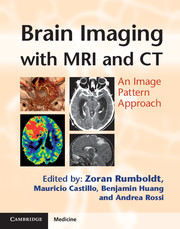Book contents
- Frontmatter
- Contents
- List of contributors
- List of abbreviations
- Preface
- Section 1 Bilateral Predominantly Symmetric Abnormalities
- Section 2 Sellar, Perisellar and Midline Lesions
- 38 Rathke's Cleft Cyst
- 39 Pituitary Microadenoma
- 40 Lymphocytic Hypophysitis
- 41 Pituitary Macroadenoma
- 42 Ectopic Posterior Pituitary Lobe
- 43 Langerhans Cell Histiocytosis
- 44 Craniopharyngioma
- 45 Hypothalamic Hamartoma
- 46 Optic Glioma
- 47 Perisellar Meningioma
- 48 Hemangioma of the Cavernous Sinus
- 49 Tolosa–Hunt Syndrome
- 50 Carotid-Cavernous Sinus Fistula
- 51 Perisellar Aneurysm
- 52 Chordoma
- 53 Chondrosarcoma
- 54 Colloid Cyst
- 55 Aqueductal Stenosis
- 56 Progressive Supranuclear Palsy (PSP)
- 57 Joubert Syndrome
- 58 Rhombencephalosynapsis
- 59 Multiple System Atrophy (MSA)
- 60 Maple Syrup Urine Disease (MSUD)
- 61 Chiari 2 Malformation
- 62 Tectal Glioma
- 63 Brainstem Glioma
- 64 Duret Hemorrhage
- 65 Hypertrophic Olivary Degeneration
- 66 Osmotic Myelinolysis
- 67 Germinoma
- 68 Pineoblastoma
- 69 Pineal Cyst
- 70 Vein of Galen Aneurysmal Malformation (VGAM)
- 71 Corpus Callosum Dysgenesis
- 72 Septo-Optic Dysplasia
- 73 Holoprosencephaly
- 74 Atretic Parietal Encephalocele
- 75 Dermoid Cyst
- 76 Lipoma
- Section 3 Parenchymal Defects or Abnormal Volume
- Section 4 Abnormalities Without Significant Mass Effect
- Section 5 Primarily Extra-Axial Focal Space-Occupying Lesions
- Section 6 Primarily Intra-Axial Masses
- Section 7 Intracranial Calcifications
- Index
- References
42 - Ectopic Posterior Pituitary Lobe
from Section 2 - Sellar, Perisellar and Midline Lesions
Published online by Cambridge University Press: 05 August 2013
- Frontmatter
- Contents
- List of contributors
- List of abbreviations
- Preface
- Section 1 Bilateral Predominantly Symmetric Abnormalities
- Section 2 Sellar, Perisellar and Midline Lesions
- 38 Rathke's Cleft Cyst
- 39 Pituitary Microadenoma
- 40 Lymphocytic Hypophysitis
- 41 Pituitary Macroadenoma
- 42 Ectopic Posterior Pituitary Lobe
- 43 Langerhans Cell Histiocytosis
- 44 Craniopharyngioma
- 45 Hypothalamic Hamartoma
- 46 Optic Glioma
- 47 Perisellar Meningioma
- 48 Hemangioma of the Cavernous Sinus
- 49 Tolosa–Hunt Syndrome
- 50 Carotid-Cavernous Sinus Fistula
- 51 Perisellar Aneurysm
- 52 Chordoma
- 53 Chondrosarcoma
- 54 Colloid Cyst
- 55 Aqueductal Stenosis
- 56 Progressive Supranuclear Palsy (PSP)
- 57 Joubert Syndrome
- 58 Rhombencephalosynapsis
- 59 Multiple System Atrophy (MSA)
- 60 Maple Syrup Urine Disease (MSUD)
- 61 Chiari 2 Malformation
- 62 Tectal Glioma
- 63 Brainstem Glioma
- 64 Duret Hemorrhage
- 65 Hypertrophic Olivary Degeneration
- 66 Osmotic Myelinolysis
- 67 Germinoma
- 68 Pineoblastoma
- 69 Pineal Cyst
- 70 Vein of Galen Aneurysmal Malformation (VGAM)
- 71 Corpus Callosum Dysgenesis
- 72 Septo-Optic Dysplasia
- 73 Holoprosencephaly
- 74 Atretic Parietal Encephalocele
- 75 Dermoid Cyst
- 76 Lipoma
- Section 3 Parenchymal Defects or Abnormal Volume
- Section 4 Abnormalities Without Significant Mass Effect
- Section 5 Primarily Extra-Axial Focal Space-Occupying Lesions
- Section 6 Primarily Intra-Axial Masses
- Section 7 Intracranial Calcifications
- Index
- References
Summary
Specific Imaging Findings
CT is incapable of showing this abnormality and thus MR is the imaging method of choice. The pituitary stalk may be absent, truncated or very thin. The adenohypophysis (anterior pituitary lobe) is generally small but may be absent. The ectopic posterior pituitary lobe (EPPL) is bright on T1-weighted images and may be located anywhere along the expected stalk or in the hypothalamus at the stalk insertion. The EPPL is generally small, 1–3 mm in diameter and does not suppress with fat saturation techniques nor does it change significantly in size and signal intensity after administration of contrast. The intrasellar posterior lobe is absent in all cases. MRI is also the best modality to show the associated brain anomalies.
Pertinent Clinical Information
EPPL is more common in males and may be associated with midline defects (holoprosencephaly, septo-optic dysplasia, Joubert syndrome, midline facial dysraphisms, cleft palate and lip, central megaincisor, Dandy-Walker type malformations, and abnormalities of the olfactory nerves – Kallmann syndrome). This condition occurs in 1 : 5000–20 000 live births. It has been associated with difficult deliveries, and shearing of the stalk during head manipulation may account for it. Children are generally of short stature and delayed physical maturation. Hormones produced by the anterior pituitary gland are of low levels or absent, while those produced by the ectopic posterior lobe are normal or of near-normal levels. Treatment is geared towards replacement of hormones and other associated anomalies.
Information
- Type
- Chapter
- Information
- Brain Imaging with MRI and CTAn Image Pattern Approach, pp. 87 - 88Publisher: Cambridge University PressPrint publication year: 2012
